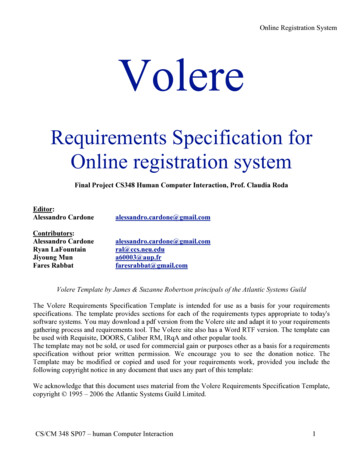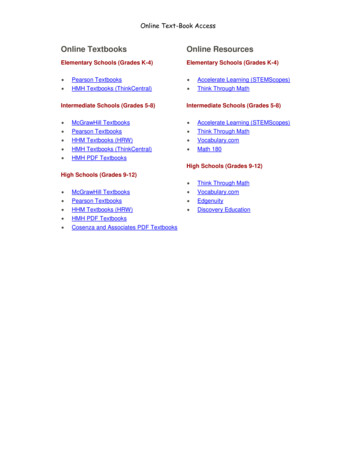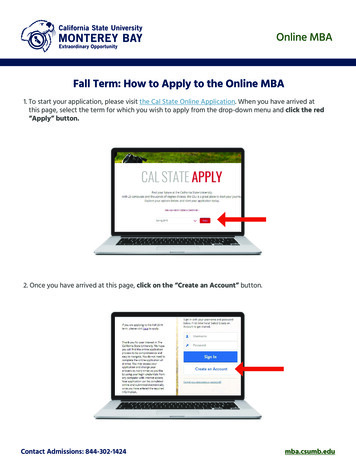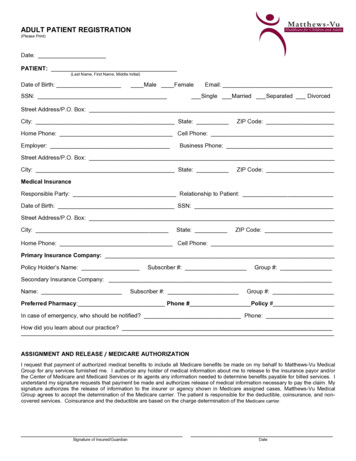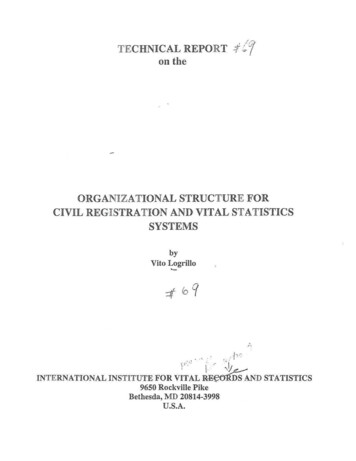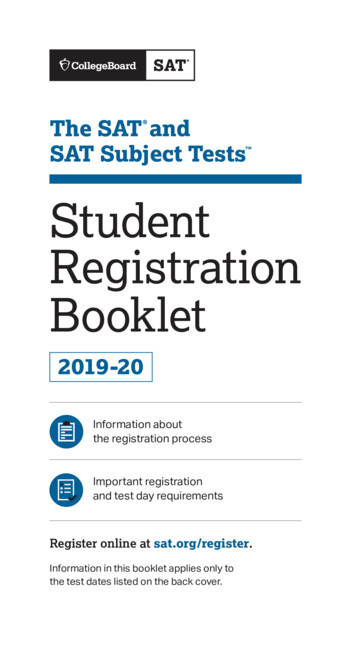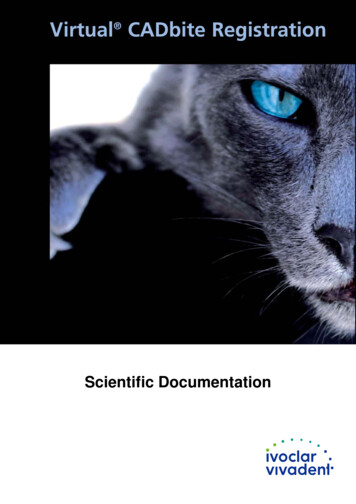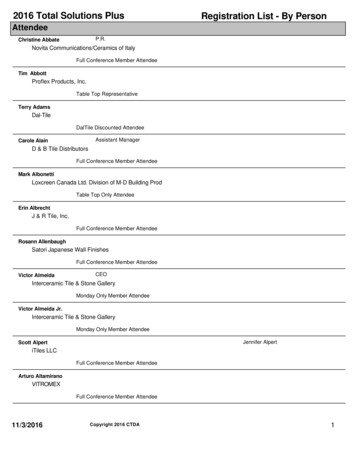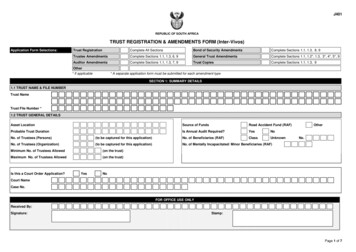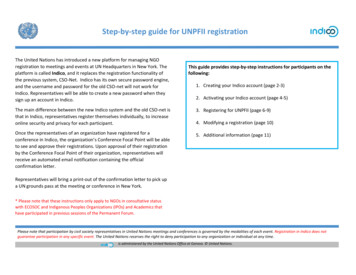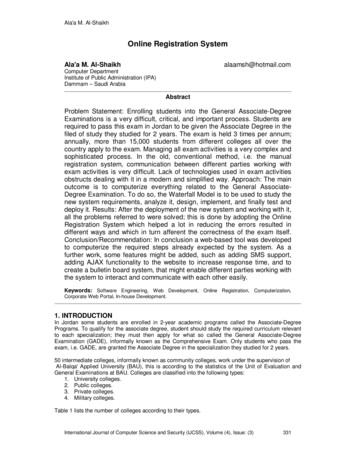
Transcription
Ala'a M. Al-ShaikhOnline Registration SystemAla'a M. Al-Shaikhalaamsh@hotmail.comComputer DepartmentInstitute of Public Administration (IPA)Dammam – Saudi ArabiaAbstractProblem Statement: Enrolling students into the General Associate-DegreeExaminations is a very difficult, critical, and important process. Students arerequired to pass this exam in Jordan to be given the Associate Degree in thefiled of study they studied for 2 years. The exam is held 3 times per annum;annually, more than 15,000 students from different colleges all over thecountry apply to the exam. Managing all exam activities is a very complex andsophisticated process. In the old, conventional method, i.e. the manualregistration system, communication between different parties working withexam activities is very difficult. Lack of technologies used in exam activitiesobstructs dealing with it in a modern and simplified way. Approach: The mainoutcome is to computerize everything related to the General AssociateDegree Examination. To do so, the Waterfall Model is to be used to study thenew system requirements, analyze it, design, implement, and finally test anddeploy it. Results: After the deployment of the new system and working with it,all the problems referred to were solved; this is done by adopting the OnlineRegistration System which helped a lot in reducing the errors resulted indifferent ways and which in turn afferent the correctness of the exam itself.Conclusion/Recommendation: In conclusion a web-based tool was developedto computerize the required steps already expected by the system. As afurther work, some features might be added, such as adding SMS support,adding AJAX functionality to the website to increase response time, and tocreate a bulletin board system, that might enable different parties working withthe system to interact and communicate with each other easily.Keywords: Software Engineering, Web Development, Online Registration, Computerization,Corporate Web Portal, In-house Development.1. INTRODUCTIONIn Jordan some students are enrolled in 2-year academic programs called the Associate-DegreePrograms. To qualify for the associate degree, student should study the required curriculum relevantto each specialization; they must then apply for what so called the General Associate-DegreeExamination (GADE), informally known as the Comprehensive Exam. Only students who pass theexam, i.e. GADE, are granted the Associate Degree in the specialization they studied for 2 years.50 intermediate colleges, informally known as community colleges, work under the supervision ofAl-Balqa' Applied University (BAU), this is according to the statistics of the Unit of Evaluation andGeneral Examinations at BAU. Colleges are classified into the following types:1. University colleges.2. Public colleges.3. Private colleges.4. Military colleges.Table 1 lists the number of colleges according to their types.International Journal of Computer Science and Security (IJCSS), Volume (4), Issue: (3)331
Ala'a M. Al-ShaikhCollege ABLE 1: Colleges in Jordan classified by typeColleges are grouped into moderates according to their geographical location. Currently, there are 13moderates spread all around Jordan Table 2, lists all moderates and the number of colleges incolleges in each moderate.No.12345678910111213Moderate NamestAmman 1ndAmman 2rdAmman 3stIrbid 1ndIrbid es6896412811211TABLE 2: List of moderates and number of colleges in each moderate1.1 Problem IdentificationFor the exam to take place, the unit of Evaluation and General Examination (UEGE), this is the unitresponsible of running and administering the exam all over the kingdom in its different stages, mustidentify the following factors:1. Total number of students who will attend the exam.2. Number of student in each specialization.3. Number of colleges whose students will attend the exam.4. What papers the students will have exams on, so UEGE can start preparing the necessaryquestions of each paper.5. The specific information about each student wishes to apply for the exam. This is to beverified and audited by UEGE to make sure all students are eligible to exam according toexam rules, regulations, legislations, and instruction.6. Exam retakers can electively retake the exam in the papers they didn’t already pass duringprevious exam sessions. However, they keep their marks in the last exam session in whichthey didn’t' pass the exam. This should also be audited by UEGE.As long moderates, and thus colleges, are distributed in different geographical locations across thecountry, its very hard, maybe it's impossible, to collect an updated version of each of the previousfactors at the time they are needed.Auditing and verifying exam-retaker mars prior to the start of the exam is very crucial. This requires alot of time and effort by the Computer Staff at UEGE. Delivering this piece of data to UEGE bycolleges in a late time may obstruct the running of the exam.The old, yet conventional method used to obtain the required data is to collect the statistics either byphone, fax, or e-mail. A UEGE's employee is named to the colleges as a coordinator; one of his/herresponsibilities is to contact colleges and moderates to get the required statistics once they needed.The higher committee of General Examinations (HCGE) at BAU is responsible of issuing all thelegislations to run the exam, which is held 3 times annually, they are the: Winter, Spring, and Summersessions. HCGE is also responsible of specifying exam appointments either for the paper-basedInternational Journal of Computer Science and Security (IJCSS), Volume (4), Issue: (3)332
Ala'a M. Al-Shaikhsection or the practical one. Accordingly, the HCGE specifies the registration duration which allowsstudents to apply for the exam.At the end of registration duration, UEGE start its final activities such as managing student seating inexam halls. Each student is given a Seat Number, which is a unique number, and it's used to identifythe student on the coming exam activities.After the expiry of registration duration, college registrars are required to correct any errors that mayappear during the registration phase. Thus, they make the necessary updates on their records, andsend them in an MS-Excel file with a predetermined format to UEGE via one of the following methods:1. E-mail.2. Floppy Diskettes.3. CD-ROMs.4. Flash Memories.5. Papers (Hard Copies)Finally, a unified MS-Excel file is complete, and it's named the Students' Base File. It containsdetailed data about the students who will actually attend the exam; and it serves as the exam'sdatabase.To summarize, the conventional manual system suffers the following problems:1. It's a hard method to communicate between UEGE and the colleges.2. Inaccurate statistical data gathered from time to time due to its dependent on the time inwhich it's ordered.3. Not all the colleges fill their students' data correctly or properly in the Excel files; neither theycomply to the predetermined file format.4. The method of data exchange between college registrars and UEGE is unsafe, in that storagemedia might be susceptible to corruption at any time.1.2 The Proposed SystemThe key solution to avoiding all the problems mentioned previously is to find a unified way to solve theproblems mentioned earlier. The only unified way is by computerization.First, registrars should find a better way to communicate with UEGE; this could only be achieved byan Online Registration System. Since the whole country is connected to the Internet, it's very easy tomake use of that feature to facilitate the way in which UEGE can monitor what's going on there in thecolleges and detect errors during the registration process once they are entered to the system.Hence, there's no need to wait until the end of the registration duration to start auditing.Not only will the system be a registration system. In fact, Online Registration is a subsystem of thewhole system.The system is a Web Portal. By definition, a Web Portal is a system that presents information from[1]diverse sources in a unified way . Contents of a portal may include reports, announcements, e-mail,[2]searches, etc .This portal is classified into a Corporate Web Portal, that is, it allows internal and external access toinformation specific to GADE.1.3 Online-Registration SystemsSeveral registrations systems are used in the Jordanian universities and colleges, some of themsupport the online registration features and some do not. Some of these systems were purchased bylocal or international software companies, and some are developed internally by the softwaredevelopment teams in the computer centers each in the relevant university or college.What makes this registration system almost distinguished when compared to others, is that it’s aSpecial-Purpose Registration System. First of all, the system is explicitly used to enroll students toexams, the General-Associate-Degree Examination (GADE); here, courses are grouped intocollections called Exam Papers.International Journal of Computer Science and Security (IJCSS), Volume (4), Issue: (3)333
Ala'a M. Al-ShaikhAn Exam Paper is a set of courses each with a definite number of questions, each question has aweight; courses of each specialty are grouped into papers each with a definite mark, when all-papermarks are added to each other final exam mark can be calculated.Secondly, this system is designated to examinations; no other system all over Jordan is used to enrollstudent for such a general examination. Purchasing a Ready-Made Application to manage GADEActivities will be impossible since GADE is the only examination in Jordan held for the AssociateDegree Students.Finally, this system is to be used by college registrars themselves not the students; most onlineregistration systems in the market and the other that are applied in the other universities and collegesare used by the students themselves.2. MATERIALS AND METHODSThe proposed system is a 3-Tier web-based. 3-Tier Architecture is a Client/Server Architecture inwhich the user interface, functional process logic (business rules), computer data storage, and data[3]access are developed and maintained as independent modules, most often in different platforms .Fig. 1 shows a 3-Tier Architecture design.2.1 The Database LayerThe proposed system's database will be implemented using Microsoft SQL Server 2005. This layerprovides high connectivity and availability, plus, it provides system developers with the ability tomanage and administer their databases easily, especially using the Graphical User Interface (GUI) ofits Management Studio. In addition to enabling developers to create their own stored procedures oruse built-in system ones.International Journal of Computer Science and Security (IJCSS), Volume (4), Issue: (3)334
Ala'a M. Al-ShaikhFIGURE 1: 3-Tier ArchitectureUsing MS-SQL Server 2005 as a Relational Database Management System (RDBMS) of the entiresolution gives the user the ability to create Server-Side Cursors to iterate programmatically throughdifferent table records and manipulate them row by row. At development time, developers may needto process resulting records at the server without the need to use another programming language, i.e.by means of the built-in functionality of the RDBMS.Never forgetting the use of triggers to perform actions on data upon insertion, deletion, or updating.All of the previously mentioned features make MS-SQL Server 2005 a good environment to host thesystem's database.2.2 The Application LayerAs shown in Fig. 1, the Application Layer contains the User Interface (UI), Business Rules, and theData-Access Components. In this system, .Net 2.0 framework is used to provide data access to theMS-SQL Server 2005 by the use of ADO.NET.All the accessing data code and business rules implementation was developed using Microsoft VisualBasic .NET; the code was written in files, each contains a class or more to handle the operations ofweb forms designed using ASP.NET.Internet Information Services (IIS) version 5.0 or later must run on the Application Server to enablethe use of ASP.NET across it.2.3 The Client LayerInternational Journal of Computer Science and Security (IJCSS), Volume (4), Issue: (3)335
Ala'a M. Al-ShaikhThe simplest client must have a PC, preferably running Windows XP as an operating system, withInternet Explorer (IE) installed to enable the users to browse the website over the Internet.As a web-based application, all processing is done on behalf of the users' computers on the serverhosting the system. So, other operating systems such as Linux, UNIX, Mac OS, etc. might beacceptable as client machines.2.4 Process ModelThe Software Development Process used in this system is the Waterfall Model shown in Fig. 2. TheWaterfall Model was chosen because of the fact that system requirements are well understood and[4]won't change during system development .FIGURE 2: The Waterfall Model.Actually, this system is designed, developed, and implemented by the Computer Staff at UEGE, so allrequirements are made by UEGE itself, which are already clear by 95% prior to starting.2.5 System OverviewFig. 3 shows the context diagram of the proposed system.FIGURE 3: System's Context DiagramInternational Journal of Computer Science and Security (IJCSS), Volume (4), Issue: (3)336
Ala'a M. Al-Shaikh[5]The Context Diagram is an overview of the system that shows its basic inputs/outputs .2.6 System Use Case DiagramUse Case Diagram is a graphical representation that describes how users will interact with theproposed system[6]. Fig. 4 shows the Use Case Diagram of the proposed system.FIGURE 4: Use Case Diagram of the Proposed System.3. RESULTSThis system comprises a number of subsystems (smaller systems) that integrate together to form theoverall system requirements and functionality.3.1 Registration Subsyst
1.3 Online-Registration Systems Several registrations systems are used in the Jordanian universities and colleges, some of them support the online registration features and some do not. Some of these systems were purchased by local or international software companies,
